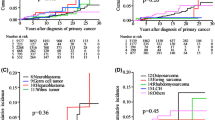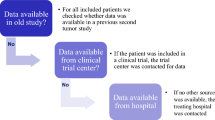Abstract
We report on a nested case–control study with 328 cases with second malignant neoplasm (SMN) following childhood cancer and 639 matched controls based on the German Childhood Cancer Registry. In the adjusted overall analysis, the odds ratio (OR) for SMN following any radiotherapy or chemotherapy is 2.1 [95% confidence interval (CI): 1.8–3.3] and 1.8 (95% CI: 0.98–3.1), respectively. The strongest effect is seen for alkylating agents (OR=2.0, 95% CI: 1.2–3.3). The risk of SMN after leukemia is pronounced for antimetabolites (OR=17.2, 95% CI: 1.7–177) and asparaginase (OR=4.3, 95% CI: 1.7–11.0). Following solid tumors, the greatest effect is seen for platinum derivatives (OR=4.1, 95% CI: 1.7–10.1). For anthracyclines, a decreased risk is observed (OR=0.3, 95% CI: 0.1–0.6). Secondary solid tumors are mainly associated with radiotherapy (OR=4.5, 95% CI: 2.5–8.0), especially secondary carcinomas. Secondary acute myeloid leukemia and myelodysplastic syndrome are mainly associated with alkylating agents (OR=8.5, 95% CI: 0.97–74.8), asparaginase (OR=6.8, 95% CI: 2.3–20.6), and platinum derivatives (OR=4.5, 95% CI: 1.5–13.6). The observed risks are in many instances lower than the ones published in previous studies relating to earlier treatment eras of the primary diseases. These differences may be attributed to less toxic but still effective treatment regimes but also to differences in the length of follow-up.
Similar content being viewed by others
Abbreviations
- ALL:
-
Acute lymphoid leukemia
- AML:
-
Acute myeloid leukemia
- CI:
-
Confidence interval
- CNS:
-
Central nervous system
- GCCR:
-
German Childhood Cancer Registry
- GPOH:
-
Gesellschaft für Pädiatrische Onkologie und Hämatologie (Society of Pediatric Oncology and Hematology)
- MDS:
-
Myelodysplastic syndrome
- OR:
-
Odds ratio
- SMN:
-
Second malignant neoplasm
- TOS:
-
Therapy optimization study (cooperative clinical trial for optimization of therapy)
- ACTD:
-
Actinomycin D
- ADR:
-
Doxorubicin
- ARAC:
-
Cytarabine
- ASP:
-
l-Asparaginase
- BLE:
-
Bleomycin sulfate
- CAR:
-
Carboplatin
- CCNU:
-
Lomustine
- CP:
-
Cyclophosphamide
- DDP:
-
Cisplatin
- DNR:
-
Daunorubicin
- DTIC:
-
Dacarbazine
- IFO:
-
Ifosfamide
- MEL:
-
Melphalan
- MITO:
-
Mitoxantrone
- MP:
-
Mercaptopurine
- MTX:
-
Methotrexate
- PRO:
-
Procarbazine
- TG:
-
Thioguanine
- VCR:
-
Vincristine
- VDS:
-
Vindesine
- VIN:
-
Vinblastin
- VM26:
-
Teniposide
- VP16:
-
Etoposide
References
Magnani C, Pastore G, Coebergh JW, Viscomi S, Spix C, Steliarova-Foucher E (2006) Trends in survival after childhood cancer in Europe, 1978-97: the ACCIS project. Eur J Cancer 42:1981–2005. doi:10.1016/j.ejca.2006.05.006
Neglia JP, Friedman DL, Yasui Y, Mertens AC, Hammond S, Stovall M, Donaldson SS, Meadwos AT, Robison LL (2001) Second malignant neoplasms in five-year survivors of childhood cancer: childhood cancer survivor study. J Natl Cancer Inst 93:618–629. doi:10.1093/jnci/93.8.618
Jenkinson HC, Hawkins MM, Stiller CA, Winter DL, Marsden HB, Stevens MC (2004) Long-term population-based risks of second malignant neoplasms after childhood cancer in Britain. Br J Cancer 91:1905–1910. doi:10.1038/sj.bjc.6602226
Meadows AT (2001) Second tumours. Eur J Cancer 37:2074–2079. doi:10.1016/S0959-8049(01)00264-7
Garwicz S, Anderson H, Olsen JH, Dollner H, Hertz H, Jonmundsson G, Langmark F, Lanning M, Möller T, Sankila R, Tulinius H (2000) Second malignant neoplasms after cancer in childhood and adolescence: a population-based case control study in the 5 Nordic countries. Int J Cancer 88:672–678. doi:10.1002/1097-0215(20001115)88:4<672::AID-IJC24>3.0.CO;2-N
MacArthur AC, Spinelli JJ, Rogers PC, Goddard KJ, Phillips N, McBride ML (2007) Risk of a second malignant neoplasm among 5-year survivors of cancer in childhood and adolescence in British Columbia, Canada. Pediatr Blood Cancer 48:453–459. doi:10.1002/pbc.20921
de Vathaire F, Hawkins M, Campbell S, Oberlin O, Raquin MA, Schlienger JY, Shamsaldin A, Diello F, Boll J, Grimaud E, Hardiman C, Langrange JL (1999) Second malignant neoplasms after a first cancer in childhood: temporal pattern of risk according to type of treatment. Br J Cancer 79:1884–1893. doi:10.1038/sj.bjc.6690300
Cardous-Ubbink MC, Heinen RC, Bakker PJ, van den Berg H, Oldenburger F, Caron HN, Voute PA, van Leeuwen FE (2007) Risk of second malignancies in long-term survivors of childhood cancer. Eur J Cancer 43:351–362. doi:10.1016/j.ejca.2006.10.004
Westermeier T, Kaatsch P, Schoetzau A, Michaelis J (1998) Multiple primary neoplasms in childhood: data from the German Children’s Cancer Registry. Eur J Cancer 34:687–693. doi:10.1016/S0959-8049(97)00326-2
Bhatia S, Yasui Y, Robison LL, Birch JM, Bogue MK, Diller L, DeLaat C, Fossati-Bellani F, Morgan E, Oberlin O, Reaman G, Ruymann FB et al (2003) Late Effects Study Group. High risk of subsequent neoplasms continues with extended follow-up of childhood Hodgkin’s disease: report from the Late Effects Study Group. J Clin Oncol 21:4386–4394. doi:10.1200/JCO.2003.11.059
Schellong G, Riepenhausen M (2004) Late effects after therapy of Hodgkin’s disease: update 2003/04 on overwhelming post-splenectomy infections and second malignancies. Klin Padiatr 216:364–369. doi:10.1055/s-2004-832340
Löning L, Zimmermann M, Reiter A, Kaatsch P, Henze G, Riehm H, Schrappe H (2000) Second neoplasms subsequent to Berlin-Frankfurt-Munster therapy of acute lymphoblastic leukemia in childhood: significantly lower risk without cranial radiotherapy. Blood 95:2770–2775
Bhatia S, Sather HN, Pabustan OB, Trigg ME, Gaynon PS, Robison LL (2002) Low incidence of second neoplasms among children diagnosed with acute lymphoblastic leukemia after 1983. Blood 99:4257–4264. doi:10.1182/blood.V99.12.4257
Pui CH, Relling MV, Behm FG, Hancock ML, Boyett JM, Raimondi SC, Krance RA, Mahmoud HH, Ribeiro RC, Sandlund JT, Head DR, Evans WE et al (1995) l-Asparaginase may potentiate effect of the epipodophyllotoxins. Leukemia 9:1680–1684
Hijiya N, Hudson MM, Lensing S, Zacher M, Onciu M, Behm FG, Razzouk BI, Ribeiro RC, Rubnitz JE, Sandlund JT, Rivera GK, Evans WE et al (2007) Cumulative incidence of second neoplasms as a first event after childhood acute lymphoblastic leukemia. JAMA 297:1207–1215. doi:10.1001/jama.297.11.1207
Maule M, Scelo G, Pastore G, Brennan P, Hemminki K, Tracey E, Sankila R, Weiderpass E, Olsen JH, McBride ML, Brewster DH, Pompe-Kirn V et al (2007) Risk of second malignant neoplasms after childhood leukemia and lymphoma: an international study. J Natl Cancer Inst 99:790–800. doi:10.1093/jnci/djk180
Cohen RJ, Curtis RE, Inskip PD, Fraumeni JF Jr (2005) The risk of developing second cancers among survivors of childhood soft tissue sarcoma. Cancer 103:2391–2396. doi:10.1002/cncr.21040
Haddy N, Le Deley MC, Samand A, Diallo I, Guerin S, Guibout C, Oberlin O, Hawkins M, Zucker JM, de Vathaire F (2006) Role of radiotherapy and chemotherapy in the risk of second leukemia after a solid tumour in childhood. Eur J Cancer 42:2757–2764. doi:10.1016/j.ejca.2006.05.034
Guerin S, Hawkins M, Shamsaldin A, Guibout C, Diallo I, Oberlin O, Brugieres L, de Vathaire F (2007) Treatment-adjusted predisposition to second malignant neoplasms after a solid cancer in childhood: a case-control study. J Clin Oncol 25:2833–2839
Borgmann A, Zinn C, Hartmann R, Herold R, Kaatsch P, Escherich G, Möricke A, Henze G, von Stackelberg A, for the ALL-REZ BFM Study Group (2008) Secondary malignant neoplasms after intensive treatment of relapsed acute lymphoblastic leukaemia in childhood. Eur J Cancer 44:257–268. doi:10.1016/j.ejca.2007.09.019
Le Deley MC, Leblanc T, Shamsaldin A, Raquin MA, Lacour B, Sommelet D, Champret A, Cayuela JM, Bayle C, Bernheim A, de Vathaire F, Vassal G (2003) Risk of second leukemia after a solid tumor in childhood according to the dose of epipodophyllotoxins and anthracyclines: a case-control study by the Societe Francaise d’Oncologie Pediatrique. J Clin Oncol 21:1074–1081. doi:10.1200/JCO.2003.04.100
Kenney LB, Yasui Y, Inskip PD, Hammond S, Neglia JP, Mertens AC, Meadows AT, Friedman D, Robison LL, Diller L (2004) Breast cancer after childhood cancer: a report from the Childhood Cancer Survivor Study. Ann Intern Med 141:590–597
Taylor AJ, Winter DL, Stiller CA, Murphy M, Hawkins MM (2007) Risk of breast cancer in female survivors of childhood Hodgkin’s disease in Britain: a population-based study. Int J Cancer 120:384–391. doi:10.1002/ijc.22261
Bassal M, Mertens AC, Taylor L, Neglia JP, Greffe BS, Hammond S, Ronchers CM, Friedman DL, Stovall M, Yasui YY, Robison LL, Meadows AT (2006) Risk of selected subsequent carcinomas in survivors of childhood cancer: a report from the Childhood Cancer Survivor Study. J Clin Oncol 24:476–483. doi:10.1200/JCO.2005.02.7235
Neglia JP, Robison LL, Stovall M, Liu Y, Packer RJ, Hammond S, Yasui Y, Kasper CE, Mertens AC, Donaldson SS, Meadows AT, Inskip PD (2006) New primary neoplasms of the central nervous system in survivors of childhood cancer: a report from the Childhood Cancer Survivor Study. J Natl Cancer Inst 98:1528–1537
Henderson TO, Whitton J, Stovall M, Mertens AC, Mitby P, Friedman D, Strong LC, Hammond S, Neglia JP, Meadows AT, Robison L, Diller L (2007) Second sarcomas in childhood cancer survivors: a report from the Childhood Cancer Survivor Study. J Natl Cancer Inst 99:300–308. doi:10.1093/jnci/djk052
Tebbi CK, London WB, Friedman D, Villaluna D, De Alarcon PA, Constine LS, Mendenhall NP, Sposto R, Chauvenet A, Schwartz CL (2007) Dexrazoxane-associated risk for acute myeloid leukemia/myelodysplastic syndrome and other second malignancies in pediatric Hodgkin’s disease. J Clin Oncol 25:493–500. doi:10.1200/JCO.2005.02.3879
Kaatsch P, Spix J (2008) German Childhood Cancer Registry—annual report 2006/07 (1980-2006). Institute for Medical Biostatistics, Epidemiology and Informatics, University of Mainz, Germany. www.kinderkrebsregister.de
Klein G, Michaelis J, Spix C, Wibbing R, Eggers G, Ritter J, Kaatsch P (2003) Second malignant neoplasms after treatment of childhood cancer. Eur J Cancer 39:808–817. doi:10.1016/S0959-8049(02)00875-4
Kramarova E, Stiller CA (1996) The International Classification of Childhood Cancer. Int J Cancer 68:759–765. doi:10.1002/(SICI)1097-0215(19961211)68:6<759::AID-IJC12>3.0.CO;2-W
Steliarova-Foucher E, Stiller C, Lacour B, Kaatsch P (2005) International Classification of Childhood Cancer, third edition. Cancer 103:1457–1467. doi:10.1002/cncr.20910
Tucker MA, Meadows AT, Boice JD Jr, Stovall M, Oberlin O, Stone BJ, Birch J, Voute PA, Hoover RN, Fraumeni JF Jr (1987) Leukemia after therapy with alkylating agents for childhood cancer. J Natl Cancer Inst 78:459–464
Pui CH, Ribeiro RC, Hancock ML, Rivera GK, Evans WE, Raimondi SC, Head DR, Behm JG, Mahmoud HH, Sandlund JT, Christ WM (1991) Acute myeloid leukemia in children treated with epipodophyllotoxins for acute lymphoblastic leukemia. N Engl J Med 325:1682–1687
Hawkins MM, Kinnier Wilson LM, Stovall MA, Marsden HB, Potok MHN, Kingston JE, Chessells JM (1992) Epipodophyllotoxins, alkylating agents, and radiation and risk of secondary leukaemia after childhood cancer. Br Med J 304:951–958
Le Deley MC, Vassal G, Taibi A, Shamsaldin A, Leblanc T, Hartmann O (2005) High cumulative rate of second leukemia after continuous etoposide treatment for solid tumors in children and young adults. Pediatr Blood Cancer 45:25–31. doi:10.1002/pbc.20380
Hawkins MM, Kinnier Wilson LM, Burton HS, Potok MHN, Winter DL, Marsden HB, Stovall MA (1996) Radiotherapy, alkylating agents, and risk of bone cancer after childhood cancer. J Natl Cancer Inst 88:270–278. doi:10.1093/jnci/88.5.270
Jenkinson HC, Winter DL, Marsden HB, Stovall MA, Stevens MCH, Stiller CA, Hawkins MM (2007) A study of soft tissue sarcomas after childhood cancer in Britain. Br J Cancer 97:695–699. doi:10.1038/sj.bjc.6603908
Debling D, Spix C, Blettner M, Michaelis J, Kaatsch P (2008) The cohort of long-term survivors at the German Childhood Cancer Registry. Klin Padiatr 220:371–377. doi:10.1055/s-0028-1086027
Acknowledgments
The authors also gratefully acknowledge the contribution by the German Society for Pediatric Oncology and Hematology (GPOH) and the associated Therapy Optimization Trials who provided data. For qualified discussion, we would like to thank especially the pediatric oncologists Prof. V. Gerein and Prof. B. Kornhuber. The authors also are grateful to the former research associates (MD) of the project (U. Derichs, G. Klein, U. Mendelssohn, B. Schulz, R. Wibbing) as well as to members of our staff (M. Decher-Neff, B. Hillebrecht, I. Kerenyi, M. Lückel) for preparing data and to I. Jung for helping with the analyses.
Financial support
The project was funded by the Federal Ministry for Education and Research in the framework of the Competence Network in Paediatric Oncology and Haematology (Funding No. 01GI0419). For ongoing financial support of the registry’s work, the authors would like to thank the Federal Ministry for Health and Social Security and the 16 ministries of health of the German states, particularly of Rhineland-Palatinate.
Author information
Authors and Affiliations
Corresponding author
Additional information
Institution in which the work was performed: German Childhood Cancer Registry, Institute of Medical Biostatistics, Epidemiology and Informatics, Johannes Gutenberg-University Mainz
Rights and permissions
About this article
Cite this article
Kaatsch, P., Reinisch, I., Spix, C. et al. Case–control study on the therapy of childhood cancer and the occurrence of second malignant neoplasms in Germany. Cancer Causes Control 20, 965–980 (2009). https://doi.org/10.1007/s10552-009-9315-1
Received:
Accepted:
Published:
Issue Date:
DOI: https://doi.org/10.1007/s10552-009-9315-1




